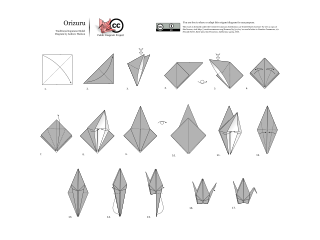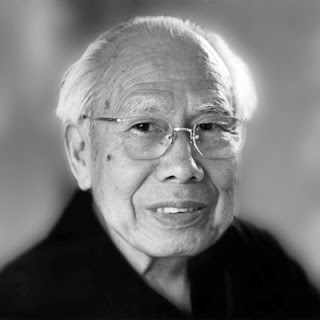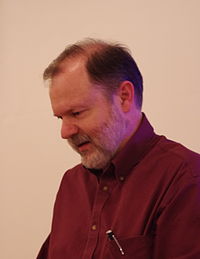
Optics is the branch of physics that studies the behaviour and properties of light, including its interactions with matter and the construction of instruments that use or detect it. Optics usually describes the behaviour of visible, ultraviolet, and infrared light. Light is a type of electromagnetic radiation, and other forms of electromagnetic radiation such as X-rays, microwaves, and radio waves exhibit similar properties.

Origami is the Japanese art of paper folding. In modern usage, the word "origami" is often used as an inclusive term for all folding practices, regardless of their culture of origin. The goal is to transform a flat square sheet of paper into a finished sculpture through folding and sculpting techniques. Modern origami practitioners generally discourage the use of cuts, glue, or markings on the paper. Origami folders often use the Japanese word kirigami to refer to designs which use cuts.

The Yoshizawa–Randlett system is a diagramming system used to describe the folds of origami models. Many origami books begin with a description of basic origami techniques which are used to construct the models. There are also a number of standard bases which are commonly used as a first step in construction. Models are typically classified as requiring low, intermediate or high skill depending on the complexity of the techniques involved in the construction.

The discipline of origami or paper folding has received a considerable amount of mathematical study. Fields of interest include a given paper model's flat-foldability, and the use of paper folds to solve up-to cubic mathematical equations.

A tessellation or tiling is the covering of a surface, often a plane, using one or more geometric shapes, called tiles, with no overlaps and no gaps. In mathematics, tessellation can be generalized to higher dimensions and a variety of geometries.

Susan Orlean is an American journalist, television writer, and bestselling author of The Orchid Thief and The Library Book. She has been a staff writer for The New Yorker since 1992, and has contributed articles to many magazines including Vogue, Rolling Stone, Esquire, and Outside. In 2021, Orlean joined the writing team of HBO comedy series How To with John Wilson.
Peter Engel is an American origami artist and theorist, science writer, graphic designer, and architect. He has written several books on Origami, including Origami from Angelfish to Zen, 10-Fold Origami: Fabulous Paperfolds You Can Make in Just 10 Steps!, and Origami Odyssey.

John Montroll is an American origami artist, author, teacher, and mathematician. He has written many books on origami, promoting the single-square, no-cut, no glue approach. Montroll taught mathematics at St. Anselm's Abbey School in Washington, D.C. from 1990 to 2021.

Akira Yoshizawa was a Japanese origamist, considered to be the grandmaster of origami. He is credited with raising origami from a craft to a living art. According to his own estimation made in 1989, he created more than 50,000 models, of which only a few hundred designs were presented as diagrams in his 18 books. Yoshizawa acted as an international cultural ambassador for Japan throughout his career. In 1983, Emperor Hirohito awarded him the Order of the Rising Sun, 5th class, one of the highest honors bestowed in Japan.

Wet-folding is an origami technique developed by Akira Yoshizawa that employs water to dampen the paper so that it can be manipulated more easily. This process adds an element of sculpture to origami, which is otherwise purely geometric. Wet-folding is used very often by professional folders for non-geometric origami, such as animals. Wet-folders usually employ thicker paper than what would usually be used for normal origami, to ensure that the paper does not tear.
Lillian Vorhaus Oppenheimer was an origami pioneer from New York City. Becoming a leading figure in the art form in her later years, Oppenheimer is credited with popularizing it in the United States. She adopted the Japanese word origami instead of the English paper folding, and the foreign term became established in the English language due to her efforts.
The Bug Wars were origami contests among members of the Origami Detectives which started when one member made a bug, a horned beetle with outspread wings, from a single sheet of paper: this design provoked other members to design more complex origami in the shape of bugs, such as wasps and praying mantises.

Rigid origami is a branch of origami which is concerned with folding structures using flat rigid sheets joined by hinges. That is, unlike in traditional origami, the panels of the paper cannot be bent during the folding process; they must remain flat at all times, and the paper only folded along its hinges. A rigid origami model would still be foldable if it was made from glass sheets with hinges in place of its crease lines.
The napkin folding problem is a problem in geometry and the mathematics of paper folding that explores whether folding a square or a rectangular napkin can increase its perimeter. The problem is known under several names, including the Margulis napkin problem, suggesting it is due to Grigory Margulis, and the Arnold's rouble problem referring to Vladimir Arnold and the folding of a Russian ruble bank note. Some versions of the problem were solved by Robert J. Lang, Svetlana Krat, Alexey S. Tarasov, and Ivan Yaschenko. One form of the problem remains open.

Ron Resch was an artist, computer scientist, and applied geometrist, known for his work involving folding paper, origami tessellations and 3D polyhedrons.

In mechanical engineering, Yoshimura buckling is a triangular mesh buckling pattern found in thin-walled cylinders under compression along the axis of the cylinder, producing a corrugated shape resembling the Schwarz lantern. The same pattern can be seen on the sleeves of Mona Lisa.
Jeannine Mosely holds a Ph.D. in EECS from the Massachusetts Institute of Technology, and is known for her work as an origami artist. She is best known for her modular origami designs, especially her work using business cards. She has organized several crowd-sourced origami projects built from tens of thousands of business cards involving hundred of volunteers for each project. She is also known for her minimalist origami designs, curved crease models, and her invention of "or-egg-ami" models made from egg cartons.
Geometric Folding Algorithms: Linkages, Origami, Polyhedra is a monograph on the mathematics and computational geometry of mechanical linkages, paper folding, and polyhedral nets, by Erik Demaine and Joseph O'Rourke. It was published in 2007 by Cambridge University Press (ISBN 978-0-521-85757-4). A Japanese-language translation by Ryuhei Uehara was published in 2009 by the Modern Science Company (ISBN 978-4-7649-0377-7).
Tomohiro Tachi is a Japanese academic who studies origami from an interdisciplinary perspective, combining approaches from the mathematics of paper folding, structural rigidity, computational geometry, architecture, and materials science. His work was profiled in "The Origami Revolution" (2017), part of the Nova series of US science documentaries. He is a professor at the University of Tokyo.















